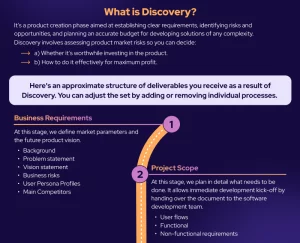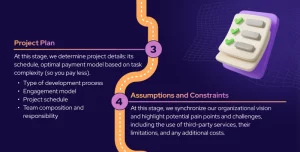You should consider the project discovery phase for software or a physical product primarily as an opportunity to save on mistakes that arise in most cases for any new development. The project discovery phase also reduces risks associated with the “rawness” of an idea. Another important result of the project discovery phase is the selection of the most modern technologies capable of ensuring the creation of the product you need. Even the most experienced can stumble here.
Read: Startup on a tight budget: how to hire a team?
Let’s give an example.
The emergence of cross-platform frameworks for mobile development such as Flutter has significantly simplified the development of mobile applications for different OSes. However, despite this happening several years ago, some businesses still look for separate developers for iOS and Android OS, which negatively impacts the project’s budget, speed, update rate, and potential scalability.
Now imagine that you and a competitor started working on similar mobile applications at the same time, but they chose a faster and more convenient technology stack that appeared this year, and you hadn’t heard about it. The competitor launches the product six months earlier than you and takes over your market.
Project Discovery Phase structure and deliverables for JetSoftPro client
The Discovery Phase comprises several critical parts, each designed to ensure a thorough understanding of the project requirements and to set a solid foundation for successful project execution. Here is a detailed breakdown of each part and the deliverables the client will receive:
1. Executive Summary.
- Overview of the key findings and recommendations from the Discovery Phase.
2. Business Requirements
2.1 Background
- Context and rationale for the project.
2.2 Problem Statement
- Detailed description of the problems the project aims to solve.
2.3 Vision Statement
- Articulation of the overall vision for the project.
2.4 Business Risks
- Identification and analysis of potential risks that could impact the project.
2.5 User Persona Profiles
- Detailed profiles of the end-users, including demographics, behaviors, and needs.
2.6 Main Competitors
- Analysis of key competitors in the market.
3. Project Scope
3.1 User Flows
- Diagrams and descriptions of the user journey through the system.
3.2 Functional Requirements
- Specific functionalities that the system must have.
3.3 Out of Scope
- Aspects and functionalities that are not included in the project.
3.4 Non-functional Requirements
3.4.1 Architecture Drivers (Quality Attributes)
- Key quality attributes that the system architecture must satisfy, such as performance, scalability, and security.
3.4.2 List of Non-functional Requirements
- Detailed list of system attributes like reliability, maintainability, and usability.
4. Project Plan
4.1 Agile Development Process
- Description of the Agile methodologies to be used in project development.
4.2 Engagement Model
- Framework for client and team interactions throughout the project.
4.3 Project Schedule
- Detailed timeline and milestones for the project.
4.4 Commercials (Project Budget, or Project Cost)
- Detailed budget and cost estimates for the project.
5. Assumptions and Constraints
5.1 Assumptions
- Assumptions made during the planning phase.
5.2 Constraints
- Limitations and restrictions that impact the project.
6. Technical Approach
6.1 Technical Direction
- High-level technical strategy and approach for the project.
6.2 Components
- Description of key system components.
6.3 Integrations
6.4 Execution Plan
6.4.1 Implementation
6.4.2 Testing Strategy
- Strategy and plan for testing the system to ensure it meets requirements.
6.5 Network Layer
6.5.1 Organization Structure
- Description of the network organization and design.
6.5.2 Network Layer
- Detailed design and specifications for the network layer.
6.6 Backup Diagram
- Diagram and plan for system backups.
6.7 Deployment Options
- Various options and strategies for deploying the system.
6.7.1 Network Structure
- Detailed network architecture.
6.8 Infrastructure Cost
- Breakdown of costs associated with infrastructure.
6.9 Environment and Hosting
- Specifications and costs for the hosting environment and infrastructure.
Advantages of the project discovery phase in one infographic
The project discovery phase is a complex topic, and we want to simplify it for you with an infographic.




How much does the project discovery phase cost?
We want to warn you right away. If someone offers you a project discovery phase for free, you will receive an extremely low-quality result. A proper project discovery phase involves specialists with 10+ years of tech and market experience, and their work is compensated accordingly. However, we are not talking about budgets that will require you to seek additional investors.
Read: Supercharge Your Startup’s Success: JetSoftPro Empowers MVP Creation for Funding Magnetism
If you have a new product in mind, write to us, and we will discuss the project discovery phase for your business. This way, you will understand whether you need to invest in this service right now or not.

